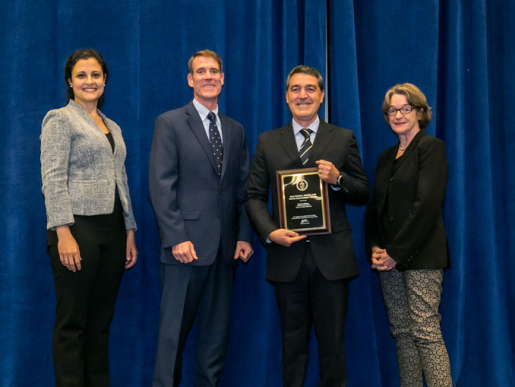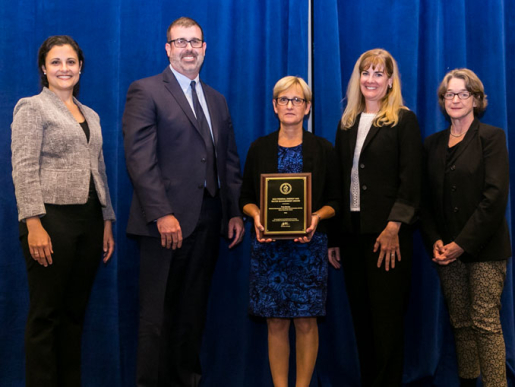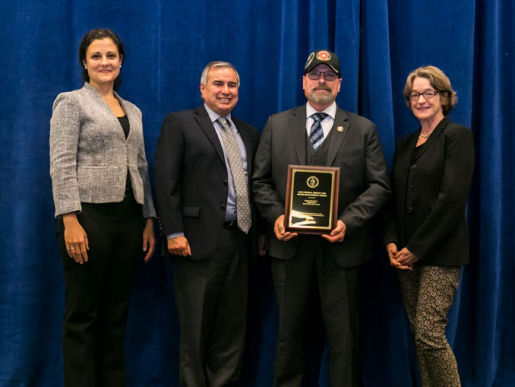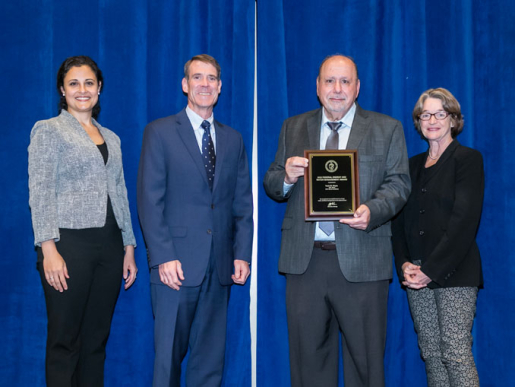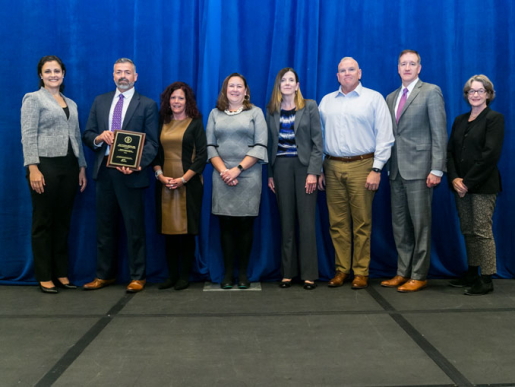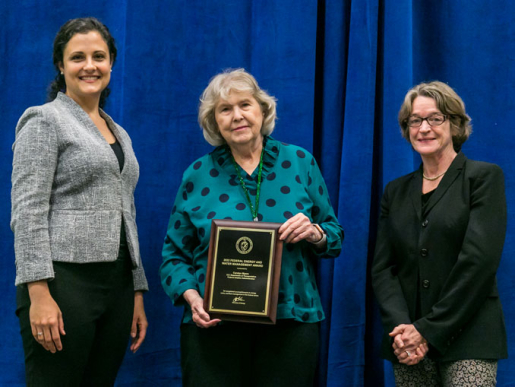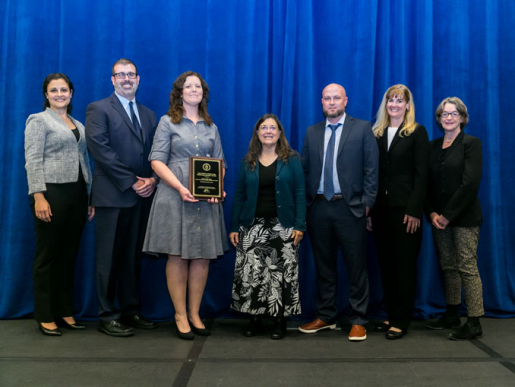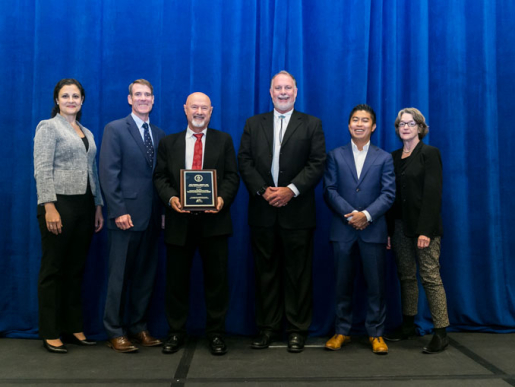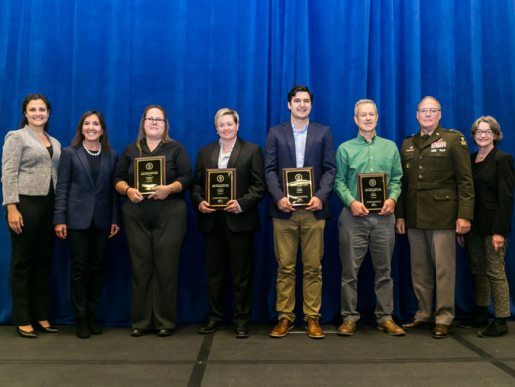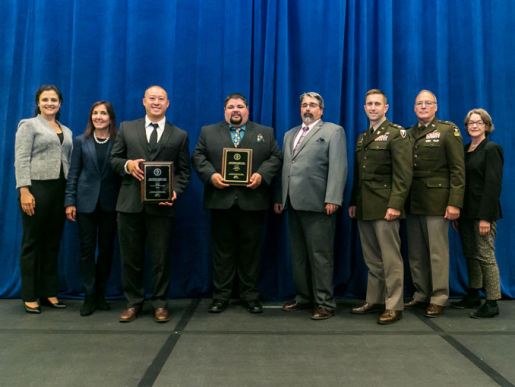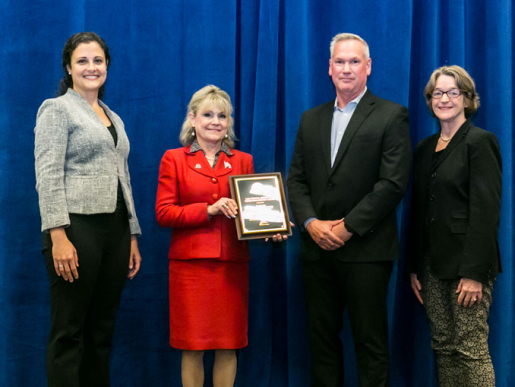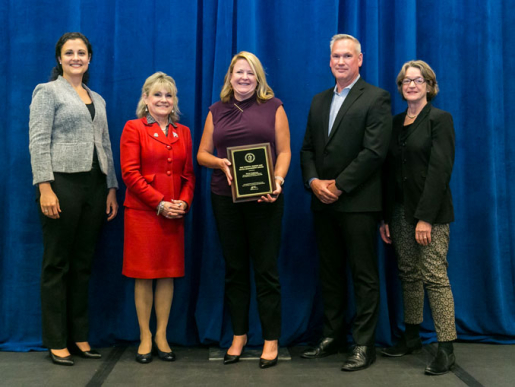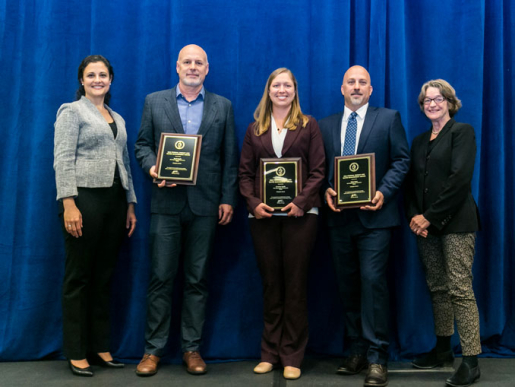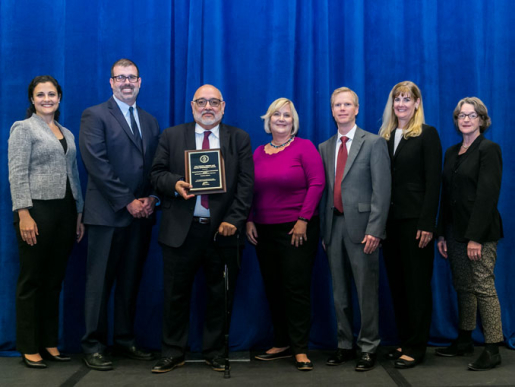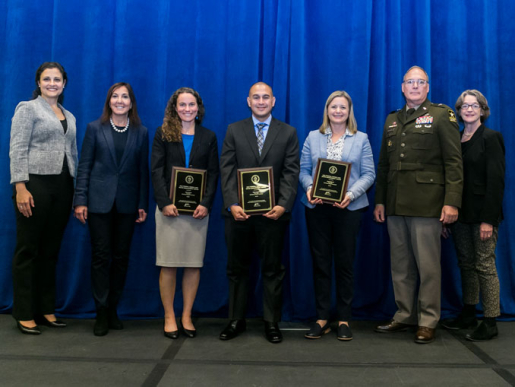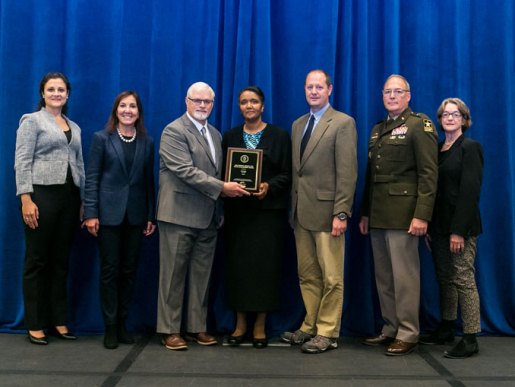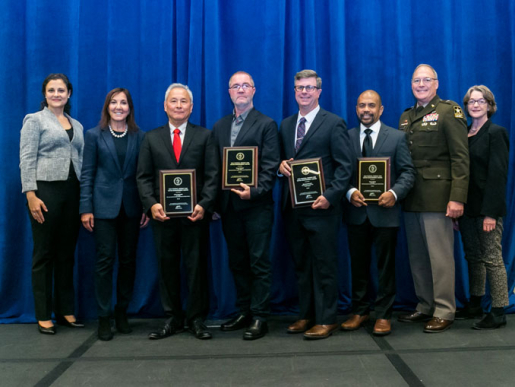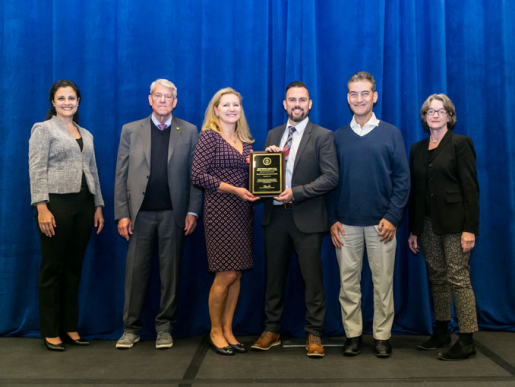The Federal Energy and Water Management Awards recognize individuals, groups, and agencies for their outstanding contributions in the areas of energy and water efficiency, resilience, and technology achievements; distributed energy; cybersecurity; and fleet management at federal facilities.
Johnny Bernal
National Aeronautics and Space Administration (NASA)
White Sands Test Facility, New Mexico
For 32 years, Johnny Bernal has provided exceptional leadership and commitment in energy, water, and fleet management. The benefits of his work have been felt throughout the agency. An expert in all logistical and functional subjects, Mr. Bernal is often called upon by NASA Headquarters to support the formulation of Agency policy, improve operations at NASA Centers, and interpret legislative requirements to ensure Agency procedures are written in accordance with federal laws and executive orders. Innovations championed by Mr. Bernal include improvements and modifications to White Sands Test Facility processes for fleet management, which significantly reduced fuel consumption and saved the facility more than $1 million annually. He was also a pioneer in reusing and recycling flight hardware following the retirement of the NASA Space Shuttle program. These efforts involved harvesting rare-earth metals and recyclable materials and have resulted in proceeds funding over $12 million in energy and water-saving projects. Mr. Bernal effectively communicates changing requirements and facilitates employee training to ensure appropriate workplace behaviors. His purview includes fleet certification, equipment management, transportation, and hazardous materials certification training.
Frances Borato
NASA
Glenn Research Center, Ohio
Ms. Frances Borato has demonstrated extraordinary commitment and technical excellence in both energy management and facilities stewardship throughout her career (30 plus years) at the NASA Glenn Research Center (GRC). Ms. Borato is the subject-matter expert responsible for mechanical building systems, which include heating, ventilating, and air conditioning (HVAC) systems; local exhaust ventilation (fume hoods); building domestic water systems; hot water boilers; plumbing systems; fire suppression systems; and the Energy Management and Control System. She collaborates with stakeholders on a daily basis to ensure sustained environmental conditions in the institutional, research, and test facilities, thus meeting the requirements for mission success while also minimizing energy and water usage. Ms. Borato’s expertise enables research and testing programs to succeed, especially as it relates to local exhaust ventilation for laboratories and test cells. She has often worked miracles specifying repairs to modern-day testing requirements, especially within laboratories and clean rooms. Additionally, from 2020-2021, she served as an HVAC COVID-19 expert for the Ohio Governor’s Office and provided insights on best practices. Her career has exemplified a dedication and passion to both energy management and facilities stewardship and has highlighted their importance to the continued success of the NASA GRC mission.
Douglas J. Conover
NASA
Johnson Space Center, Texas
In his role as Water, Sewer, and Bridge Systems Manager, Mr. Conover has given more than 30 years of tireless dedication and superior service to Johnson Space Center (JSC), Sonny Carter Training Facility (SCTF) and Ellington Field (EF). Mr. Conover has been responsible for the management and oversight of all potable water systems, sewage operations and bridge integrity. His attention to detail has ensured safe drinking water for NASA’s personnel, thereby mitigating water and energy infractions throughout his long tenure. While rigorously maintaining this critical function on a daily basis, Mr. Conover has expanded his role in recent years, managing the implementation of new technologies that can more readily identify problems in the water-treatment process. Finally, his coordination with utility providers, local municipalities, and the Texas Water Authority has been an invaluable feature of his exceptional service.
Randy J. Monohan
U.S. Marine Corps
Marine Corps Installations Command, Virginia
Over the past two decades, Mr. Randy Monohan has championed and executed countless energy and water-efficiency projects at Marine Corps Installations. Most recently, in his role as the Energy Projects Officer for Marine Corps Installations Command (MCICOM), he has been instrumental in identifying, developing, and awarding over $1.5 billion in infrastructure investments to improve their reliability, resilience, and efficiency. Mr. Monohan has pioneered the use of appropriated funds in conjunction with performance contracts, improving the viability of energy savings performance contracts and utility energy service contracts. Through these contracting mechanisms, Mr. Monohan comprehensively improved the efficiency and resiliency of the installations in his charge. His unwavering leadership has helped installations envision and achieve long-term plans, such as Marine Corps Logistics Base Albany’s achievement of Net Zero Electricity status and Marine Corps Air Station Miramar’s ability to withstand a 21-day power outage. Over his distinguished career, Mr. Monohan has been recognized with two Presidential Energy Awards, ten Group Secretary of the Navy Energy Awards, and numerous program, project, and contracting Federal Energy and Water Management Awards.
Antonio Piluso
U.S. Navy
Naval Air Station Sigonella
AE Africa Canada Europe Armed Forces
Mr. Antonio Piluso has served as an energy leader for the Navy Enterprise for more than 19 years. During his career, he has been recognized twice with the FEMP FEDS Spotlight Award for Command Energy Champions due to his innovation and collaboration in the field. Mr. Piluso is a proven leader in his field, both within Navy Region Europe, Africa, Central (EURAFCENT) and the U.S. Navy. In 2019, he planned and hosted, for the first time in the region’s history, the Energy Management Summit to train and equip all of EURAFCENT’s Installation Energy Managers in the field. Mr. Piluso personally trained and presented to the attendees at the summit. Additionally, he taught Energy Savings Best Practices at the Naval Post Graduate School in Monterey. Mr. Piluso takes a forward-leaning approach to the execution of the Sigonella energy program. He is in constant communication with key installation stakeholders to execute his program. He regularly interfaces with Base Communication Office to identify fiber conversion and inventory-gathering strategies. Mr. Piluso works closely with Utility Energy Management (UEM) Branch to develop all infrastructure projects, such as the new Smart-Grid project P-139 for Sigonella, while training and supporting new UEM personnel.
Gene Curtiss
U.S. Army
Directorate of Public Works
Fort Bliss, Texas
Mr. Gene Curtiss has been Fort Bliss Champion for the past 15 years, leading the way in energy conservation by managing Fort Bliss’ Utility Monitoring Control System (UMCS), which involves system accreditation, building re-tuning, and meter management. Mr. Curtiss has been managing the UMCS as one of his Contracting Officer’s Representative (COR) duties. These duties included constructing the UMCS’s Risk Management Framework (RMF) accreditation of the Fort Bliss UMCS which covers 365 buildings on Fort Bliss. Mr. Curtiss has been responsible for solely operating and training contract technicians to ensure the UMCS is operating, reading data properly, and managing all system alarms. Without his tireless work and subject matter expertise, Fort Bliss would not have an RMF package and would be unable to operate the UMCS system which not only monitors Fort Bliss critical building systems, but it supports energy savings by ensuring HVAC systems operate as designed.
Yasin El-Mayta
U.S. Navy
Naval Station Activity (NSA)
Annapolis, Maryland
Mr. Yasin El-Mayta, NSA Annapolis’ acting Installation Energy Manager (IEM) has performed above and beyond to optimize the efficiency and resiliency of the buildings throughout the entire campus by collaborating with building managers and the Retro-Commissioning Team. He is a constant professional with unparalleled dedication to the Navy since 1989 along with four years serving as the Dual-Hatted Planner and IEM at NSA Annapolis. In his 33 years of service, Mr. El-Mayta worked as a civil engineer for over 14 years and a community planner for the past 13 years. Mr. El-Mayta applies innovative ideas in all project development efforts, including the management of a solar panel project and an electric vehicle charging station project to ensure enhanced reliability, resilience, and efficiency. As a community planner, Mr. El-Mayta’s area of responsibility included completing DD1391’s, energy project development, as well as resilience, utility, and technical infrastructure support. He developed critical Navy Energy Program products including the Installation Energy Program Summary (IEPS), which provides a holistic overview of an installation’s energy program to track progress.
Donald Swedinovich Jr.
NASA
Glenn Research Center, Ohio
Mr. Donald Swedinovich has demonstrated outstanding leadership and commitment to energy stewardship during his 50-year tenure at the NASA Glenn Research Center (GRC). He serves as the lead for utilities and scheduling for GRC. Mr. Swedinovich is the Center’s Utility Contracting Officer’s Representative and the Operations Scheduling Lead within the Facilities Infrastructure Division for providing services to the aeronautics and space testing facilities. Mr. Swedinovich coordinates the Center’s test schedule to align with the mission needs, while also demonstrating utility stewardship. He has saved the Center millions of dollars throughout his career by effectively managing utility demand.
Jacob Vigil
Andrea Kincaid
Cynthia Ralph
Christine Bond-Jawish
Steven Slater
Defense Logistics Agency (DLA)
DLA Energy, Installation Energy
Virginia
During FY 2021, DLA Energy team members Ms. Andrea Kincaid, Ms. Cynthia Ralph, Mr. Jacob Vigil, Mr. Keith Carvalho, Ms. Christine Bond-Jawish, Ms. Anna Muldowney, and Mr. Steven Slater were awarded four task orders (TOs) and one TO modification against the Department of Energy Indefinite Delivery Indefinite Quantity (DOE IDIQ) contract in support of Langley AFB, Cannon AFB, Hurlburt Field, the U.S. Coast Guard Training Center (USCG TRACEN), and Kunsan AB. The actions, valued at a total of $176,387,881 will provide more than $118,081,148 in third-party investment to implement 24 energy conservation measures (ECMs) resulting in an annual energy savings of 253,549 MMBTUs for customers. The above projects represent 56% of the total project investment and 63% of the total annual energy savings awarded in FY2021 under the DOE IDIQ contract. The DLA Energy ESPC team demonstrated their expertise in the utilization of the unique acquisition authority provided under 42 U.S. Code 8287, Authority to enter into contracts, to effectively utilize performance contracting and private sector financing to implement facility energy improvements in support of advancing mission readiness and energy resilience objectives for DoD and federal customers.
Cory Taylor
Jennifer Hill
Karen Rivaud
Nathan Bickel
Matthew Pomeroy
Creative Use and Refinement of Recurrent Performance Contract Process
National Aeronautics and Space Administration
Kennedy Space Center, Florida
In July of 2021, the NASA Kennedy Space Center (KSC) Utility Energy Services Contract (UESC) Phase 1 team completed a four-year-long effort to award a $19.4 million UESC to Florida Power and Light. The UESC Phase 1 includes significant cost savings and avoidance by reducing maintenance efforts to aging equipment, allowing for a more operationally efficient facility base for Kennedy’s programs. This project consists of using a financed performance contract that bundles a diverse mixture of energy conservation measures to provide energy savings, resilience, efficiency, and security to 22 facilities that support critical NASA missions. This required creative use, refinement, and enhancement of a KSC performance contract process to implement approved energy conservation measures recurrently, which resulted in the successful award of UESC Phase 1. The UESC resulted in $19.4 million in energy efficiency improvement investments and provides savings of $1.4 million annually for the government.
Nigel Morrissey
Pamela Frank
Kevin Ngo
Hossam Kassab
Bruce Delling
NAVFAC Southwest, Commander Navy Region Southwest - Naval Weapons Station Seal Beach, Naval Munitions Command High Efficiency Dehumidification System
U.S. Navy
Naval Weapons Station Seal Beach, NAVFAC Southwest and CNRSW, California
In FY21, Commander Navy Region Southwest (CNRSW), Naval Facilities Engineering Systems Command (NAVFAC) Southwest (SW) collaborated with the local utility, Southern California Gas Company, to execute a Utility Energy Service Contract (UESC). This third-party financed project addressed the HVAC system at Naval Weapons Station Seal Beach (NWSSB). This is critical infrastructure for the major tenant, Naval Munitions Command (NMC) for which the HVAC system exceeded its useful life in 2020 and NMC failed to meet mission requirements, due to the lack of humidity and temperature control. Per NAVFAC’s Energy Project Management Guide, these one-time, non-recurring, non-energy savings were estimated to be over $4.8M. NAVFAC SW worked with the local utility and evaluated various solutions, ultimately determining that the High Efficiency Dehumidification System (HEDS) met mission needs and provided the highest overall labor, maintenance, and energy cost savings. The annual energy savings from all energy conservation measures are estimated to be 9,922 MBTU's ($680K) for the life of this contract.
Carolyn R. Myers
Renewable Energy Contract Award Nomination
U.S. Department of Transportation (DOT)
DOT Federal Aviation Administration (FAA) Central Service, Texas
Carolyn Myers, a Real Estate Contracting Officer, re-negotiated 87 utility contracts for FAA facilities which will now receive 100% renewable energy. Ms.Myers's efforts will result in more than 4,000 MWh/year of renewable energy for the agency and significantly help the FAA meet the goals outlined in Executive Order 14057. In addition, these contracts were negotiated at a cost below the market rate for standard electricity. Therefore, the FAA expects to save approximately $500,000 over the five-year term of the contract. Ms. Myers's efforts have led to new draft procedures for all Real Estate Contracting Officers, which should produce similar results throughout the agency's facility profile.
Audrey Oxendine
Ray Throop
Dan Lewis
Tony Bryant
Tammy Temple
Fort Bragg Energy Team
U.S. Army
Fort Bragg Directorate of Public Works (DPW), North Carolina
In 2021, Fort Bragg’s Energy team implemented innovative energy management practices to better organize their activities given the dynamic challenges that face all federal organizations. One best practice implemented was instituting and utilizing the 50001 Ready Energy Management System. With the support of DOE, Army, and guidance from consulting firm Advanced Energy, Fort Bragg became the only Army site and one of only two Department of Defense components to complete the 25 tasks and certify 50001 Ready. Through implementing 50001 Ready, they gained a renewed commitment from top leadership and improved communication lines to team members inside DPW and key contractors. They have also been able to apply novel technologies to solve energy resiliency challenges. Examples include a 1.1 MW floating solar array and complementary 2 MWh battery energy storage system at a Special Forces training site, an ongoing microgrid demonstration of a unique distribution protection device - the IntelliRupter PulseCloser Fault Interrupter from S&C Electric Co., and the construction of multiple units of the High Efficiency Dehumidification System technology that graduated from DoD’s ESTCP accelerator program.
Lorenzo Ortiz
Alex Hui
Varun Sood
Eric McKay
Michael Hoffman
Multi-Year Planning Guides Resilient Operations at Fort Hunter Liggett
U.S. Army
Fort Hunter Liggett, California
Located on the Central Coast of California, Fort Hunter Liggett (FHL) is recognized as one of the military’s premier Total Force Training Centers. FHL’s resiliency initiatives resulted in 23.2% of the installation's energy being produced from renewable sources in FY21 equaling nearly $900,000 in savings. Additionally, FHL integrated 45 buildings into a base-wide energy management control system that would become the Integrated Installation Control Center. FHL was the only U.S. Army site featured in a White House Sustainability Showcase in FY21 highlighting their resiliency planning efforts, infrastructure modernization, and resiliency best practices. Furthermore, FHL broke ground on a $21M Energy Resilience and Conservation Investment Program microgrid project. The project will update the medium voltage distribution system with manageable distributions connected to a central Supervisory Control and Data Acquisition system and install an additional 3.75MW of photovoltaic generation with a 2.5MW/5MWh Battery Energy Storage System.
Douglas Tucker
Christian Paasch
Seema Aziz-Hall
Judith Willis
SAF/IEE Installation Energy Program
U.S. Air Force
Virginia
Mr. Douglas Tucker, Ms. Judith Willis, Ms. Seema Aziz-Hall, and Mr. Christian Paasch for mission assurance via the Installation Energy Strategic Plan (IESP) and resulting initiatives shepherded the Department of the Air Force (DAF) Installation Energy Program toward an actionable framework of energy and water resilience. In January 2021, SAF/IEE published the IESP, which lays out three goals – Identify Enabling System Vulnerabilities, Improve Resilience Planning, and Ensure Resilience Results –to support the installation energy vision of “Mission Assurance through Energy Assurance.” The IESP is an innovative living roadmap to establish end-to-end energy resilience and builds upon previous resilience messaging established by the program. SAF/IEE has gone above and beyond in service of the mission, for example, establishing Energy Resilience Readiness Exercises as a cornerstone to both mission assurance and energy assurance efforts across the Department. SAF/IEE developed the Water Dashboard as a first-of-its-kind tool with an interface that users were already familiar with, reducing costs and time for users to learn the software. SAF/IEE worked with stakeholders across Headquarters Air Force to ensure collective buy-in of the Risk and Resilience Assessment and Emergency Response Plan. Additionally, in October 2021, the DAF announced that it would be conducting a first-of-its-kind micro-reactor Pilot Program at Eielson AFB. The next-generation energy technology is expected to provide the installation with a clean, reliable, and resilient energy supply for critical national security infrastructure, and inform future resilience applications for the enterprise. These initiatives led the DAF to reduce energy use intensity on its installations by 3.55% in FY21 from the previous year and 31.87% from the FY03 baseline, and to reduce water intensity by 9.4% in FY21 and 26.8% from the FY07 baseline.
Brian Yerby
Victor Avalos
Amy Solana
Emily Wendel
9th Mission Support Command Microgrid at Pele U.S. Army Reserve Center (ARC)
U.S. Army
9th Mission Support Command, Hawaii
Headquartered in Honolulu, Hawaii, the 9th Mission Support Command is nominated in the Project Award category for launching the first fully functioning energy microgrid in the U.S Army Reserve at Pele U.S. Army Reserve Center (ARC). The $2.1 million Energy Resilience and Conservation Investment Program project combined 325-kilowatts of new roof-mounted solar photovoltaic, a new 345-kilowatt hour battery storage system, and an existing 300-kilowatt generator. In FY20, before the microgrid installation, Pele ARC consumed 734.4 megawatt hours (MWh) of electricity at a cost of $227,880. In FY21, in only seven months of operation, the ARC reduced its utility provided consumption to 415.6 MWh at a cost of $117,960.71, resulting in a 48% reduction in utility costs. The site’s energy use intensity dropped from 370 million British Thermal Units (mmBTUs)/thousand square foot (ksf) during FY20 to 209 mmBTUs/ksf in FY21. In the first 12 months of continuous operation, the system generated 483 MWh of electricity and offset 300 tons of carbon dioxide emissions. The microgrid also provides the U.S. Army Reserve an important capability to continue operations during natural disasters and support first responders at home base. The addition of battery modules will increase Pele ARC s storage capacity for use in the event of a DSCA operation where the utility could fail to provide power. Additionally, increased battery storage will save diesel fuel used for the generator during long outages. This will stretch the 1,000 gallons of fuel stored in the generator tank for several more days of power
Whitney Ray
Mark Fincher
Fort Benning Microgrid Node at Dixie Rd Substation
U.S. Army
Fort Benning, Georgia
Fort Benning developed a strategic plan for an installation-wide microgrid and constructed the first node on Main Post. This node consists of 9.75 MW of natural gas generators at the Dixie Road substation, distribution automation devices placed at strategic locations throughout the Main Post 12KV distribution lines to be able to isolate to smaller circuits, and an Automatic Transfer Scheme (ATS). The ATS acts as the "brain" of the system, giving the grid the ability to "self-heal" by using analytics to pinpoint the segment where the fault is occurring, automatically switch the route of electrons to isolate the problem area, and restore power to as many locations as possible, all in under one minute. Looking specifically at Main Post cantonment area, where generators and distribution automation were installed, there was a 46% decrease in outage time and 74% decrease in areas affected by the outages. On May 4, 2021, Fort Benning lost one of the three main external power feeds to the installation. Before the microgrid system was in place, this disruption would have been a major reportable event that could have lasted hours before restoring power to a large part of the installation. However, during this event, the ATS restored power to all facilities in approximately 31 seconds. As a result, the Fort Benning Directorate of Public Works (DPW) received zero calls regarding power loss during this incident. The generators can also be used for economic dispatch during times of high real-time prices (>$0.10/kWh). The savings from economic dispatch covers the costs of operation and maintenance each year.
Jeffrey Williamson
H. Sandy Walker
Michael Kerr
Daniel McCallister
Hadassa Baker
Fort Riley Energy Savings Performance Contract (ESPC) Phase III
U.S. Army
Fort Riley, Kansas
USAG Fort Riley, KS, home of the Army’s 1st Infantry Division successfully completed the third phase of a multi-phased Energy Savings Performance Contract (ESPC) in October 2020. The Fort Riley ESPC Phase III project was awarded on September 30, 2019, and accepted on October 8, 2020. The project provided $6,386,941 in facility improvements across 48 buildings and approximately 1 million square feet. The project included four energy conservation measures (ECMs) covering four different technology categories. ECMs included central chiller plant upgrades, infrared heating system improvements, building lighting and controls upgrade, and retro-commissioning. The verified cost savings at the end of year 1 of the performance period were $321,801, and exceeded the guaranteed annual savings of $317,563. The project provided 22,369 million BTUs of energy savings in year 1, the equivalent of 1,939 metric tons of carbon dioxide emissions avoided, or 418 gasoline-powered passenger vehicles off the street. This energy savings equates to 26% in energy reduction in the buildings affected.
Karl Berg
Joshua Guerra
Leo Shortsleeve
David Wong
Hanscom Air Force Base (HAFB) Project Award Nomination - Cogeneration / Gas Take Station
U.S. Air Force
66 ABG/CE, Massachusetts
In 2021, HAFB completed the construction of an Energy Resilience and Conservation Investment Program (ERCIP) project to install a natural gas take station and simultaneously completed the construction of a 4.6 MW cogeneration plant under an energy savings performance contract (ESPC). The ERCIP was a highly complex project that constructed a new delivery point on the Kinder Morgan interstate gas pipeline that crosses HAFB. This project was plagued from the beginning by design deficiencies and required close coordination between Kinder Morgan (pipeline owner), contractor, the local utility, ESPC contractor, and gas system O&M contractor. This project successfully delivered a take station to include both high-pressure and low-pressure distribution. More importantly, this project provided the high-pressure gas needed that made the cogeneration plant a reality. In 2021, a cogeneration plant was also commissioned. This plant is capable of producing 4.6 MW of electricity as well as 40,000 PPH of 100 psi steam. This new asset represents the single largest energy resiliency improvement ever made on HAFB and provides over $3M a year in energy savings. As part of the project, HAFB also changed how it procures natural gas. In FY21 HAFB successfully transitioned from the retail gas market to the wholesale gas market. With Massachusetts being a deregulated State, this effectively eliminated the need to pay a transportation tariff to the local utility company. Although HAFB only saved $88,294 in FY21, future year savings will be over $1M a year in transportation costs.
Kelly Baldwin
Ron Bowles
Heating, Ventilation, and Air Conditioning (HVAC) Upgrade
U.S. Department of Homeland Security (DHS)
U.S. Customs and Border Protection
Air and Marine Operations, San Diego Air and Marine Branch, Washington
U.S. Customs and Border Protection (CBP) replaced aging heating, ventilation, and air conditioning (HVAC) equipment at the U.S. Border Patrol (USBP), Blaine Sector Headquarters in Blaine, Washington. These targeted enhancements to systems controls, sequences, and operations improve the maintenance and operation of existing systems to make them more efficient. Additionally, it restores the building’s infrastructure and environmental conditions and provides cost savings in operations. FY21 showed 506 MBTU savings compared to the average of the three previous years and the commissioning of the completed initiative shows the project will realize an estimated overall energy usage decrease of 34% or 1,445 MBTU resulting in an annualized cost savings of more than $20,000. Additionally, implementing DCV in a facility can reduce the minimum outside air intake and thus the need to condition outside air. Compared to standard design occupancy, law enforcement buildings tend to be over or under-occupied. Typically, agents need indoor and outside space for law-enforcement activities. Therefore, surges in activity are frequent. Coupling zonal control systems and adding thermostats that also have carbon dioxide (CO2) detectors allow the building to maximize heating efficiency by utilizing the minimum in make-up air. This also allows fine-tuning of the outside air to ensure adequate and healthy air levels without excess CO2 buildup. This ensures occupant safety while maximizing energy savings.
Robert Baker
Tasha Golson
Bridgette Rodgers
Robert Moseley
Col. Heather Blackwell
Keesler Air Force Base Energy Savings Performance Contract (ESPC)
U.S. Air Force
Keesler Air Force Base, Mississippi
In FY 2021, Keesler AFB and NORESCO completed the construction of an ESPC project with $64.6 million in guaranteed energy savings. The project, contracted through DLA Energy and in collaboration with AFCEC, helps the base advance resiliency, security, and renewable energy usage while reducing deferred maintenance and energy costs. The scope of work included a 1.5MW solar photovoltaic (PV) carport array at the Base commissary built to withstand hurricane force winds. It also integrated several different legacy control systems into a single, cybersecure Energy Management Control System with over 14,900 points across 37 buildings, optimized chilled water plants, and upgraded nearly 30,000 light fixtures with LEDs. The solar PV system provides clean energy and makes significant progress toward current decarbonization goals of 100% carbon pollution-free electricity by 2035. The expected emissions reductions from Keesler AFB ESPC are 29,974,634 lb/year of carbon dioxide, 88,259 lb/year of sulfur oxides, and 26,613 lb/year of nitrogen oxides. This is the equivalent of saving 14,103 acres of average forest or 3,622 cars removed from the road.
Scott Ingalls
Christine Smith
Brian Vasel
LEED Construction in the Arctic: The New NOAA Barrow Atmospheric Baseline Observatory
U.S. Department of Commerce (DOC)
NOAA, Alaska
The NOAA Barrow Atmospheric Baseline Observatory is the northernmost LEED-certified building in the U.S. Arctic and demonstrates the ability to build a sustainable federal research facility in one of the most challenging locations in the country. This NOAA team led the effort to design and build the new NOAA Barrow Atmospheric Baseline Observatory (BRW) in Utqiagvik, Alaska. Utqiagvik is located at 71°N along the North Slope of Alaska with no road access to the community. It experiences months of total darkness and snow-cover for over half the year. A requirement by this team was for the facility to meet LEED certification as this would provide for a finished building with a high-level of construction quality and energy savings incorporated throughout the design and construction process. The building has already achieved a LEED-Silver designation (57 credits total) and may still qualify for a LEED-Gold certification (60 credits) as the final credits are awarded and three other credits are appealed. The new BRW building is the farthest north LEED-certified building (of any type) and now matches the other Federal LEED-Silver facility in the U.S. Arctic, the NOAA National Weather Service building also located in Utqiagvik. The new BRW site became operational in October 2021 (start of FY21). With the new and fully operational facility, the energy consumption has been dramatically reduced (saving 26% from FY20) despite the new building being over three times larger. This translates to a cost savings of almost $10K ($9,780) in the first year of operation.
Elkin Vargas
David Valentin
Mayaguez Off-Grid Solar
U.S. Department of Agriculture
Tropical Agriculture Research Station, Puerto Rico
Elkin Vargas, Administrative Officer, and David Valentin, Maintenance Worker, at the Tropical Agriculture Research Station in Mayaguez, Puerto Rico, installed an off-grid solar array to replace a nonfunctioning UPS on expensive, sensitive chemistry lab equipment. The station purchased an inverter, a Lithium Battery, and 9 KW of roof-mounted solar modules furnishing 85% of the lab’s power. The same system was also installed on a housing unit with 11.9 KW of solar modules. A 12’ x 15’ seed cooler was moved from an earthquake-damaged building into the bungalow and is now powered 100% by renewable energy. This addresses chronic problems with low voltage, power outages, and power surges as well as the price of electricity made primarily with fuel oil in Puerto Rico. The systems produce clean reliable power and have backup generators. The total estimated annual savings calculated using PVWatts will be 33,091 kWh and $8,934. The island of Puerto Rico has suffered from repeated hurricanes and earthquakes that have damaged its already fragile electrical grid, and the unemployment rate was 7.9% in August 2021 when this project was implemented. Fossil fuels provide 97% of Puerto Rico’s electricity with a mix of coal, fuel oil, and natural gas. This off-grid solar project provided stimulus to the local economy while avoiding carbon emissions from grid electricity and generators used by TARS and supports the mission of the laboratory to further Puerto Rico’s agriculture.
Evelyn Baskin
Ernest Wayne Phillips
Sarah Austin-Blevins
Andrew Komm
Sherry McCray
NASA GSFC EBCx Project
National Aeronautics and Space Administration (NASA)
Goddard Space Flight Center (GSFC) EBCx Project Team, Maryland
GSFC manages operations for dozens of NASA and international space missions including the James Webb Telescope, Hubble Space Telescope, Explorer Program, Discovery Program, and Earth Observing System, among other missions and observation programs. To address GSFC’s energy reduction and facility operational performance goals more effectively, the GSFC Energy Team developed an Existing Building Commissioning (EBCx)/Retro-commissioning (RCx) project in four of its highest energy-consuming buildings improving equipment serving 640,456 square feet (SF) and rehabilitating 69 heating ventilating and air conditioning (HVAC) air conditioning systems (ACS) units. Utilizing FEMP’s best practices, GSFC developed the EBCx project under the Government Services Administration (GSA) area-wide contracting mechanism, thereby taking advantage of benefits provided by its local utility, Potomac Electric Company (PEPCO). The initial investment of $2.5 million leveraged available rebate incentives and is projected to annually provide $395,000 in cost savings, energy savings, and reduce greenhouse gas emissions.
Terrence G. White
Steven Pereira
Staci Sadoyama
Dylan Okada
Bryan Law
Navy Pacific Missile Range Facility (PMRF) EUL - PV / Battery Storage
U.S. Navy
Navy Pacific Missile Range Facility, Hawaii
In March 2021, a 19.3 MWdc photovoltaic (PV) solar array with 70 megawatt-hour battery energy storage system (BESS) on board PMRF began commercial operation. This project is a showcase of successful collaboration between PMRF and its local electric utility Kauai Island Utilities Cooperative (KIUC) utilizing an Enhanced Used Lease (EUL) authorized by U.S.C. 2667. KIUC and its developer, AES Distributed Energy (AES), own and operate this PV + BESS on 140 acres of non-excess Navy land under a 37-year agreement. This project accelerates the adoption of low-cost renewable energy and benefits Kauai ratepayers during evening peak usage hours. As part of the in-kind consideration, KIUC constructed energy resilience infrastructure improvement for PMRF and established microgrid black-start capability, which significantly enhanced PMRF’s energy security and resilience and will improve mission assurance in response to potential power grid disruptions. The microgrid was initially commissioned to a small portion of the installation in April 2021 and later expanded to cover the installation in June 2022. Through the IKC, PMRF has direct access to the PV+BESS plant. Solar production during the 12 months since commercial operation totaled 27,674 MWH (94,423 MMBTU), avoided petroleum fuel for electricity production totaled 2,129,633 gallons, and greenhouse gas avoided totaled 29,418 metric tons (CO2 equivalent). The cost savings for Kauai ratepayers equaled $2.1 million with savings calculated by subtracting solar energy contract costs from avoided cost of petroleum fuel.
Matthew Vogel
Matthew Carriveau
Martin Navarro
NOAA Minimizing Fresh Water Consumption at the La Jolla Aquarium
U.S. Department of Commerce (DOC)
California
This project was awarded for designing and installing new equipment for the Aquarium life-support system that uses filtered seawater instead of potable water for backwashing sand filters. Upgrading the system reduces potable water consumption and wastewater discharge, both of which are better for the environment, while also reducing annual operating costs. This upgrade enables the facility to save approximately 400,000 gallons of potable water per year — a 20% decrease in total potable water consumption for the facility, utilities, operations, and maintenance of nearly $11,400 per year. Flushing each sand filter is required at a minimum of twice weekly and there are two filters. At a cost of $0.0158 per gallon of domestic water the annual savings from this reduction in usage would be near $6,400. A conservative figure will save approximately an additional $5,000 per year, bringing the total annual savings to $11,400. The SWFSC experimental aquarium is where experiments are conducted to validate assessment parameters, aid in the recovery of Endangered Species Act listed species, improve aquaculture procedures, and address impacts of rockfish barotrauma. Adding additional system reliability to a critical research facility that provides so many benefits to the environment is important, but to also make the process more efficient is a bonus. Before this system was installed, it was necessary to flush seawater through the sand filters after each backwash to remove any residual potable water from the filters prior to placing them back in service. This flush was approximately 5gpm for 90 minutes. This equates to approximately 100,000 gallons of seawater per year, which would have ended up in the sanitary sewer system. Reducing potable water usage and minimizing discharge to the sewer directly benefit the environment.
Amalia Thomas
Pilot Scale Wastewater Treatment and Energy Production Technology
U.S. Army
Tobyhanna Army Depot, Pennsylvania
A cooperative effort between Tobyhanna Army Depot, U.S. Army Corps of Engineers ERDC and CERL, and the Pennsylvania State University to develop and implement a pilot-scale microbial fuel cell (MFC) using air cathodes for producing electricity while treating wastewater. The combined MFC/BF technology treated domestic wastewater, consuming only 0.13 Watt hours (Wh) for every one liter of wastewater (Wh/L), which is more than 75% lower than that of conventional wastewater treatment at 0.6 Wh/L. Throughout the demonstration, the MFC treated approximately 29,059 gallons (110 m3) of wastewater, with a volumetric power generation (Watt hours per cubic meter of wastewater treated) of 18 Wh m–3, with peaks of 37 Wh m–3 over a one-week operation. At the end of the demonstration stage, approximately six months from the time of installation, measurements and analysis of post-treatment sampling showed that the total organic and inorganic solids, as well as bacterial removal rate from wastewater generated was 50% more, using the MFC/BF treatment as compared to conventional treatment. There are savings associated with MFC/BF treatment through both energy cost savings and improved bacterial removal rates. The MFC removed up to 64% of chemical oxygen demand (COD), while up to 97% of COD was removed in the combined MFC/BF process. COD is the amount of oxygen needed by both organic and inorganic solids to exhaust. Other contaminants and chemicals of concern, such as biological oxygen demand (BOD), ammonia, nitrate, nitrite, TSS, E. coli, and fecal coliforms were drastically abated in the MFC alone, with removal rates up to 90% for chemicals in the MFC/BF overall technology.
Keith Yamanaka
Travis Fellinger
Monte Martin
Stanford Yamada
Michael DeCaprio
Schofield Generating Station Microgrid Load Control
U.S. Army
U.S. Army Garrison Hawaii, Directorate of Public Works, Hawaii
On May 22-23, 2021, U.S. Army Garrison Hawaii (USAG-HI) DPW and Hawaiian Electric Company (HECO) completed a successful black-start exercise for Schofield Barracks, Wheeler Army Airfield, and Field Station Kunia using manual load control. This validated the ability of the Schofield Generating Station (SGS) microgrid to restore power to all three installations within 2 hours and sustain all loads for 33 hours using 100% renewable energy. DPW and HECO coordinated their actions to perform 184 switching operations to successfully separate from the grid, restore power with SGS, interconnect 2 MW of PV and transfer back to the grid with no deviation in power quality or trip events. Savings is the avoided cost of installing a computer-controlled load system and remote switch operation estimated to be $13 million. The primary tangible benefit is that this control system is not vulnerable to cyber-attack and utilizes personnel requirements already in place to support day-to-day functions of both the Army and HECO. The requirement to utilize personnel for load control ensures that knowledge and capabilities are maintained. The success of the project has strengthened the Army and HECO partnership for energy goals, project development, and now operationalization of renewable resilience.
Marcus Watkins
Jose Flores
Amanda Hezel
Galen Brown
Scott Trotier
NASA Jet Propulsion Laboratory Data Center Consolidation Project
National Aeronautics and Space Administration
NASA Jet Propulsion Laboratory Data Center
California
In October 2020, NASA Jet Propulsion Laboratory completed the implementation of a landmark data center resilience, consolidation, and efficiency project. NASA leveraged the DOE ESPC to implement comprehensive data center upgrades that required extreme coordination across numerous stakeholders to minimize impacts to critical spaceflight operations. The data center upgrades delivered cutting-edge power and cooling efficiency and resiliency, supporting communications with tens of billions of dollars of NASA satellites (including planetary exploration missions like Mars 2020). With millions of dollars of annual energy and operational savings, this project demonstrates the potential impact of data center consolidation and how ESPCs can address strategic infrastructure priorities, even in demanding environments with uninterruptible missions and highly technical requirements. This project was completed ahead of schedule and produced significant savings in its first year. Excess savings were achieved by decommissioning the B600 Data Center ahead of schedule. As a result of the early decommissioning of the B600, first-year verified savings of $2.7 million exceeded the guaranteed savings by $1.8 million. This project reduced NASA’s annual energy consumption by 12.6 million Btu as a result of decommissioning data centers with PUEs over 2.00.
Wendy Neighbours
Allen Quick
Howard Cabiness
Byron D. Perry Sr.
Tracy Storme
Vehicle Telematics Initiative - Data Modernization Efforts
U.S. Department of Homeland Security (DHS)
Customs and Border Protection
Washington, D.C.
To comply with federal fleet management standards issued by the Government Accountability Office (GAO), U.S. General Services Administration (GSA), Presidential Memorandums, the DHS Stop Asset and Vehicle Excess (SAVE) Act, and the DHS Fleet Manual, U.S. Customs and Border Protection (CBP) installed motor vehicle telematics technology on more than 22,000 vehicles. This technology automates vehicle data collection and aggregation, providing timely, high-quality fleet performance data, fuel type usage, and miles per gallon per vehicle resulting in Greenhouse Gas emissions. The data will not only allow CBP Fleet Managers to make better vehicle acquisition, disposition, maintenance, repair, and operational decisions, but also provide data early in the process for converting internal combustion engines to electric vehicles per Executive Order 14057/DHS mandate to convert 50% of fleet to Electric Vehicles by 2030. The large size and deployment footprint of the CBP fleet necessitated geospatial analysis and site surveys to determine data connection technical solutions at each operating location. Completion of this initiative has allowed CBP to better maintain their fleet and help determine fuel efficiency for the existing vehicles. The initiative also eliminated 53,000 labor hours by frontline operators to manually record vehicle utilization data with an estimated savings of more than $2.7 million annually.
Award Winners' Ceremony
For the first time in the history of FEMP's Federal Energy and Water Management Awards, the 2021 and 2022 award winners were honored in person during Energy Exchange 2022. This live, invite-only ceremony was held on October 26, 2022, in Cincinnati, Ohio, at the Duke Convention Center. Learn more about the award winners ceremony.

